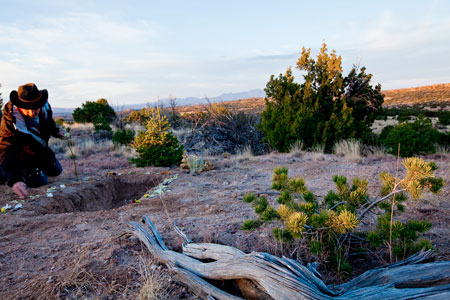WASHINGTON (CNS) – Many people focused on maintaining a sustainable lifestyle can now expand this to end-of-life practices as “green” or natural funerals and burials join the rising movement toward sustainability.
Sustainable burial practices include efforts to protect the health of workers, conserving natural resources, minimizing carbon emissions, and conserving and repairing the environment.
“Sustainability is something that should be in our DNA as Catholic Christians,” said Father Charles Morris, president of the Green Burial Council International, a nonprofit organization that promotes and sup- ports sustainable funeral practices.
Father Morris, from Wyandotte, administrator for Mount Carmel Cemetery in Wyandotte, the first U.S. Catholic cemetery certified by the Green Burial Council. The cemetery permits the use of plant-based embalming fluids and biodegradable caskets. It also gives families the option to use shrouds instead of cas- kets in burials.
“The experience of a green burial where the family lays the body down in a shroud that they have made and takes turns putting dirt in the grave is very powerful and profoundly spiritual,” he said.
James Olson, spokesperson for the National Funeral Directors Association, based in Brookfield, Wis., said some of the most common natural burial practices include using caskets made of seagrass, wicker, fiberboard and sustainable woods, using natural shrouds and no embalming fluids or nonformaldehyde-based embalming fluids. All the details of the process usually feature biodegradable materials.
He said sustainable burial practices are not a new concept, but they have evolved over time, especially after World War II.
In previous times throughout history, natural burials were more common, Olson explained. Today many cemeteries require a concrete burial vault to protect from collapse when using heavy maintenance equipment such as lawnmowers. After an increase in machinery fol- lowing World War II, practices such as the concrete vaults were incorporated into burial preparations.
Olson said cost often does not play a role in families’ decisions to have a natural burial. He said the resources used for traditional funerals are more readily available and there- fore often less expensive than those used in green burials and funerals. Father Morris said people might be reluctant to use sustainable burial practices because of lack of exposure to the idea and resistance among some funeral providers to accommodate green burial practices.
“Until people have the experience of a green burial it is difficult for them to know what is involved and the impact it can have,” he said. “As with any new practice, or in this case a rediscovery of a very old practice, there are those who are early adopters. But for the rest of the pub-lic, it will take a while (to catch on).”
For him, green burials make sense because “we are all ‘part of,’ not ‘apart from’ creation” and “sustainable burial practices bring that all home.”

